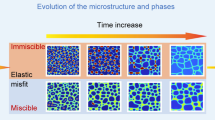Abstract
The molecular dynamics method has been used to simulate mode I cracking in Ni3Al. Close attention has been paid to the process of atomic configuration evolution of the cracks. The simulation results show that at low temperature, the Shockley partial dislocations are emitted before the initiation of the crack propagation, subsequently forming the pseudo-twins on (111) planes in crack-tip zone, and then the crack cleavage occurs. The emitting of the Shockley partial dislocations accompanies the crack cleavage during the simulation process. At the higher temperature, the blunting at the crack tip is caused by the [110] superdislocations emitted on (100) plane. The present work also shows that the dipole dislocations on (111) planes in the 1/2[110] dislocation core can be formed.











Similar content being viewed by others
References
A. Kelly: Strong Solids Oxford University Press London, UK 1966 22
J.R. Rice G.E. Beltz: The activation energy for dislocation nucleation at a crack. J. Mech. Phys. Solids 42, 333 1994
J.R. Rice: Dislocation nucleation from a crack tip: An analysis based on the Peierls concept. J. Mech. Phys. Solids 40, 239 1992
J.R. Rice R. Thomson: Ductile versus brittle behaviour of crystals. Philos. Mag. 29, 73 1974
J.P. Hirth J. Lothe: Theory of Dislocations Wiley New York 1968 201
S.J. Zhou, A.E. Carlsson R. Thomson: Crack blunting effects on dislocation emission from cracks. Phys. Rev. Lett. 72, 852 1994
Korner Exhaustion of a [10-1](111) slip to explain the strength anomaly in Ni3(Al,Ti). Philos. Mag. A 63(3), 407 1991
C.T. Chou P.B. Hirsch: Computer simulation of motion screw dislocations in Ni3Al. Philos. Mag. A 68(6), 1097 1993
B. Devincre, P. Veyssière, L.P. Kubin G. Saada: A simulation of dislocation dynamics and of the flow stress anomaly in L12 alloys. Philos. Mag. A 75, 1263 1997
A.H.W. Ngan, M. Wen C.H. Woo: Atomistic simulations of Paidar–Pope–Vitek lock formation in Ni3Al. Comput. Mater. Sci. 29, 259 2004
Y.S. Choi, D.M. Dimiduk, M.D. Uchic T.A. Parthasarathy: Modelling plasticity of Ni3Al-based L12 intermetallic single crystals. I. Anomalous temperature dependence of the flow behaviour. Philos. Mag. 87, 1939 2007
N. Baluc R. Schaublin: Weak beam transmission electron imaging of superdislocation in ordered Ni3Al. Philos. Mag. A 74(1), 113 1996
M. Dao, B.K. Kad R.J. Asaro: Mechanism of intense failure in Ni3Al single crystals. Philos. Mag. A 75(2), 443 1997
Z.W. Shan, X. Wu, L. Liu, J.H. Yang Y.B. Xu: In situ transmission electron microscopy investigation of crack propagation in single crystal Ni3Al. Mater. Sci. Technol. 17, 1398 2001
A.F. Voter S.P. Chen: High temperature ordered intermetallic alloys in Characterization of Defects in Materials, edited by R.W. Siegel, J.R. Weertman, and R. Sinclair (Mater. Res. Soc. Symp. Proc. 82, Pittsburgh, PA, 1987), p. 175
V. Shastry D. Farkas: Molecular statics simulation of fracture in α-iron. Mater. Sci. Eng. 4, 473 1996
J.E. Angelo M.I. Baskes: Interfacial studies using EAM and MEAM. Interface Sci. 4, 47 1997
D. Farkas, D. Roqueta, A. Vilette K. Ternes: Atomistic simulations in ternary Ni–Ti–Al alloys. Modell. Simul. Mater. Sci. Eng. 4, 359 1996
Y. Mishin, D. Farkas, M.J. Mehl D.A. Papaconstantopoulos: Interatomic potentials for monoatomic metals from experimental data and ab initio calculations. Phys. Rev. B 59, 3393 1999
F.J. Cherne, M.I. Baskes P.A. Deymier: Properties of liquid nickel: A critical comparison of EAM and MEAM calculations. Phys. Rev. B 65, 024209 2001
J.E. Angelo, N.R. Moody M.I. Baskes: Trapping of hydrogen to lattice defects in nickel. Modell. Simul. Mater. Sci. Eng. 3, 289 1995
T. Zhu C-Y. Wang: Misfit dislocation networks in the γ/γt phase interface of a Ni-based single-crystal superalloy: Molecular dynamics simulations. Phys. Rev. B 72, 014111 2005
P. Veyssiere, M. Shimotomai P. Beauchamp: On the presence of superlattice intrinsic stacking faults in plastically deformed Ni3Al. Philos. Mag. A 51, 469 1985
K. Hemker M.J. Mills: Measurements of antiphase boundary and complex stacking fault energies in binary and B-doped Ni3Al using TEM. Philos. Mag. A 68, 305 1993
H.P. Karnthaler, E.T. Muhlbacher C. Rentenberger: The influence of the fault energies on the anomalous mechanical behaviour of Ni3Al alloys. Acta Mater. 44, 547 1996
A. Paxton Y.G. Sun: The role of planar fault energy in the yield anomaly in L12 intermetallics. Philos. Mag. A 78, 85 1998
G. Schoeck, S. Kohlhammer M. Fahnle: Planar dissociations and recombination energy of [110] superdislocations in Ni3Al: Generalized Peierls model in combination with ab initio electron theory. Philos. Mag. Lett. 79, 849 1999
S. Kohlhammer, M. Fahnle G. Schoeck: The structure of [010] dislocations in Ni3Al. Scripta Mater. 39, 359 1998
Y. Mishin: Atomistic modeling of the γ and γ′-phases of the Ni–Al system. Acta Mater. 52, 1451 2004
L. Hua, H. Rafii-Tabar M. Cross: Molecular dynamics simulation of fractures using an N-body potential. Philos. Mag. Lett. 75, 237 1997
A. Machova G.J. Ackland: Dynamic overshoot in α-iron by atomistic simulations. Model. Simul. Mater. Sci. Eng. 6, 521 1998
M.P. Allen D.J. Tildesley: Computer Simulation of Liquids Oxford University Press New York 1987 83
Acknowledgments
This research was supported by National Basic Research Program of China (Grant No. 2006CB605102) and National Natural Science Foundation of China (Grant No. 90306016).
Author information
Authors and Affiliations
Corresponding author
Rights and permissions
About this article
Cite this article
Xie, HX., Wang, CY. & Yu, T. Atomistic simulation of fracture in Ni3Al. Journal of Materials Research 23, 1597–1603 (2008). https://doi.org/10.1557/JMR.2008.0192
Received:
Published:
Issue Date:
DOI: https://doi.org/10.1557/JMR.2008.0192




